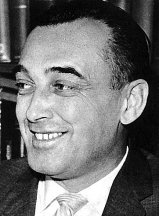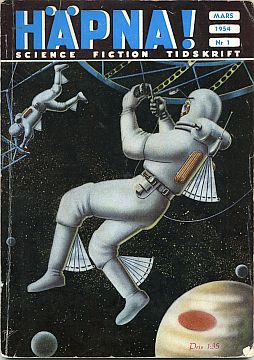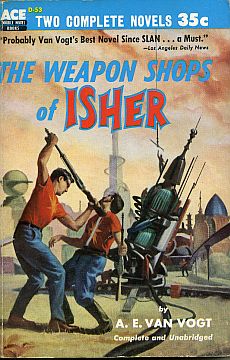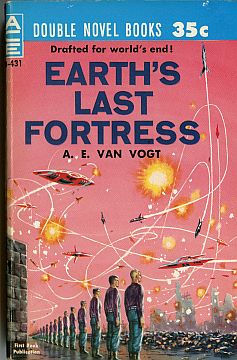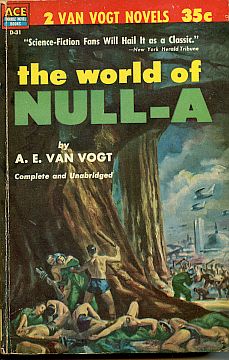|
The
World of Null-A - A. E. van Vogt
|
||||||||||||
I doubt that our literary tastes are genetically programmed. Probably, chance events are equally important in influencing our choices. Be that as it may, at age 13 I became a passionate reader of science fiction stories. The triggering event was the birth of a Swedish science fiction magazine, "Häpna!". (The name means "Be amazed!", no doubt a reference to the magazine "Astounding Science Fiction".) The first issue in March 1954 contained some riveting stories. In one of them, "Repulsion Factor" by Charles Eric Maine, a scientist has invented teleportation: a physical object is disassembled in a transmitter and sent as information to a receiver where it is reassembled (just as in Star Trek). A murderer uses this device to create a copy of himself by using two receivers, intending to let "his copy" take the rap. - In addition to being an exciting story, it made me thoroughly confused over the real nature of identity and consciousness. (Cf. "The Mind's I" by Hofstadter and Dennett.) It also contained the first installment of a novel by A. E. van Vogt, "Slan", which described the ruthless persecution of a genetically engineered race of human telepaths. (It may have been inspired by the fate of the European Jews, even though it was written as early as 1940.) - In subsequent issues of Häpna!, van Vogt was a frequent contributor, and I always enjoyed his original stories, often with an unexpected twist at the end.
That same year I read "Destination Universe", a collection of short stories, in Swedish. I soon graduated to reading van Vogt's stories in English, at first with some difficulty. I enjoyed such classics as "The Voyage of the Space Beagle"(which much later formed the basis for the movie "Alien"), and "The Weapon Shops of Isher", along with works by Arthur C. Clarke, Ray Bradbury, Isaac Asimov, Alfred Bester, Robert Heinlein and many others. What set van Vogt apart from the rest was his unfettered imagination, the grandeur of his vision, and his predilection for assigning superhuman powers to his heroes, such as telepathy, immortality, encyclopedic knowledge, teleportation, superior mental capabilities, etc. It sometimes seemed as if he had too many ideas for the scope of his stories, and there are many loose ends in his works. To a timid teenager, it was hard to resist throwaway lines such as: "...made it necessary for Robert Hedrock, Earth's one immortal man, ... to make sure ...", or "The seesaw would end in the very remote past, with the release of the stupendous temporal energy he had been accumulating.... He would not witness but he would aid in the formation of the planets." ("The Weapon Shops of Isher); "'There is only one such expert aboard', said Grosvenor coldly" ("The Voyage of the Space Beagle" - how often have I had to suppress similar sentiments in committee meetings :-) ); "When he found himself suddenly back on Earth in another man's body, it was more than he had expected" (the backside blurb of "The Man with a Thousand Names"); "I suggested that they turn their attention to other galaxies" ("The War Against the Rull").
When I found "The World of Null-A" in a bookshop, I knew that I was in for a good read. "Could just this one man block a cosmic conspiracy?" said the blurb. As usual with van Vogt, the main character, Gilbert Gosseyn had been endowed with superhuman powers - in this case an extra brain that allowed him to achieve the teleportation of objects, including himself. On the other hand, he suffered from amnesia and had no idea who he was or what his purpose was. The plot centered on his struggle to find out. An interesting device was that the story was set in an environment 600 years in the future, where society was built on the principles of General Semantics. There were numerous allusions to this "science", including a reference to "Korzybski Square". Evidently, training in General Semantics was very beneficial in helping a person withstand the shock of being instantaneously transported from Earth to Venus at the whim of some unknown manipulator. Among the actors is a "Games Machine, made up of 25,000 electronic computers". - Wow! (Irony intended!) My father used to make disparaging remarks about my choice of literature. (However, in my Grandfather's memoirs, at age 18 "he only smiles mildly when the conversation turns to Schiller or Goethe."...) Still, I caught him reading both "The World of Null-A" and its sequel "The Pawns of Null-A". Today, at age 13, my son Christofer devours Japanese Manga comics magazines. Perhaps I should not be too harsh on him :-) The allusions to "the science of General Semantics" piqued my curiosity. I found out that Alfred Korzybski really existed and had written a book called "Science and Sanity". Evidently, van Vogt was an early admirer of Korzybski. Later he developed an interest in scientology, but was quickly disillusioned. Although some of Alfred Elton van Vogt's admirers like to claim that he had to be an extraterrestrial to be able to write such books, he really was an author of flesh and blood. He was born in Winnipeg, Canada, in 1912, became a fulltime writer in 1941, and moved to Los Angeles in 1944. He died there in 2000, a victim of Alzheimer's disease. Further reading
|
||||||||||||
